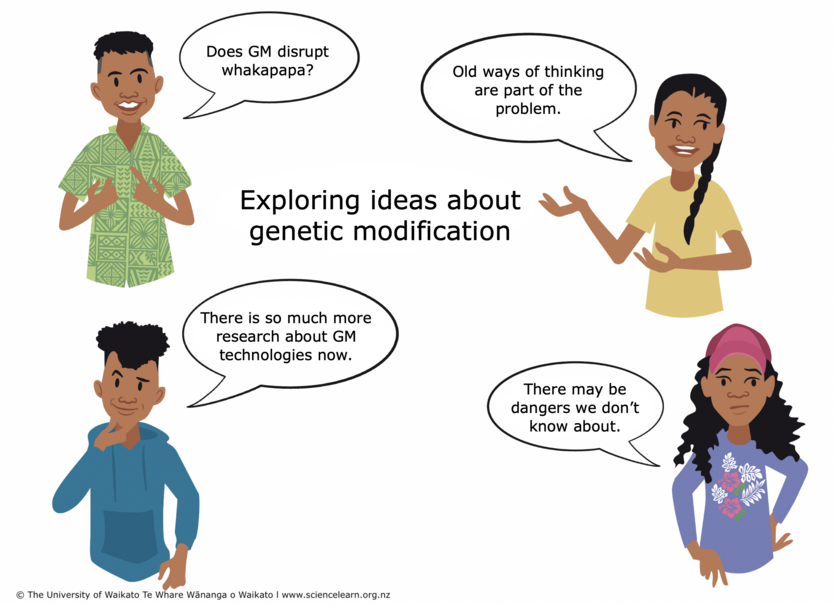Genetic modification has been used in Aotearoa New Zealand since the 1970s. It is used in research laboratories and in contained field tests, in some medicines and medical research and as part of science-based courses. This research is strictly controlled – no one can import, develop, field test or release a genetically modified organism without approval from the Environmental Risk Management Authority.
New Zealand’s laws and regulations governing genetic modification are among the most rigorous in the world, and strike a balance between protecting our health and environment and preserving opportunities for all types of production genetically modified and non-genetically modified.
Genetic modification – the New Zealand approach, Ministry for the Environment
In 2019, Royal Society Te Apārangi published reports on gene editing scenarios and regulations. The expert panel concluded: “It’s time for an overhaul of the regulations. There’s an urgent need for wide discussion and debate about gene editing within and across all New Zealand communities.” The panel also noted, “New Zealand needs to have its own perspective given our unique cultural heritage and environment, and the special challenges we face in maintaining our biodiversity.”
Is there a place for using RNAi in Aotearoa?
The fundamental aim of biotechnology is to solve problems and make useful products. RNA interference (RNAi) – a form of gene technology – has the potential to help with the vexing issue of pest control in Aotearoa. RNAi is being trialled in the United States to assist with varroa mites and in Australia to slow the spread of myrtle rust.
New Zealand’s BioHeritage National Science Challenge, whose mission from 2014 to 2024 was to protect and manage biodiversity and biosecurity, recognised that gene technologies may potentially be useful in pest eradication. The BioHeritage Challenge noted that science plays multiple roles in building knowledge, addressing societal issues and concerns and informing policy.
In this activity, students use a variety of resources to consider personal, societal and science perspectives and make a science-informed response to the use of RNAi as a means of pest control.
By the end of this activity, students should be able to:
- use resources to aid understanding of the basic biology that underpins genetic technologies
- use resources to aid understanding of the threats posed by varroa and myrtle rust
- use resources to aid understanding of te ao Māori perspectives regarding gene technologies for pest control
- use resources to aid understanding of public perspectives of the benefits and risks associated with gene technologies
- use concept cartoons to consider aspects of genetic modification and RNAi
- use concept cartoons to justify/position their ideas on the issues
- discuss/create a science-informed response to the potential use of RNAi as a means of pest control.
Download the Word file (see link below).
RNA interference – a context for learning curates Hub resources on RNAi, provides pedagogical information and links to the New Zealand Curriculum and Te Mātaiaho.
Related content
The following resources provide background information. Use them to gather information.
Biology basics
- RNA interference
- RNA interference – key terms
- DNA, chromosomes and gene expression
- Proteins – what they are and how they’re made
- Cell biology and genetics
Varroa mites
Myrtle rust
Te ao Māori perspectives
- RNAi for pest control – te ao Māori considerations
- Kaitiakitanga with Tame Malcolm – webinar
- Tame Malcolm – indigenous pest management – webinar
The article Using concept cartoons provides information about pedagogical methodologies and approaches when using concept cartoons.
The article Managing classroom discussions has tips on facilitating discussions in a positive, safe atmosphere.
Useful links
This activity supports NCEA level 1.1 Demonstrate understanding of a science-informed response to a local issue.
The following resources provide background information. Use them to gather information.
Biology basics
-
Gene editing technologies – Royal Society Te Apārangi
Varroa mites
- Protecting Honey Bees: An effective and long lasting new mode of action for varroa control – Greenlight Biosciences
- New direction for varroa control research – University of Arkansas
Myrtle rust
- Kauri ora – BioHeritage National Science Challenge
- Myrtle ora – BioHeritage National Science Challenge
- Scientists tackle rusty plant threat – University of Queensland
New Zealand Government reports and regulations
- Genetic modification – the New Zealand approach – Ministry for the Environment, 2004
- Hazardous Substances and New Organisms Act 1996 – New Zealand Legislation, 1996
- Report of the Royal Commission on Genetic Modification – Ministry for the Environment, 2001
New Zealand science organisations
- National Conversations on Genetic Technologies for Environmental Purposes – New Zealand's Biological Heritage National Science Challenge, 2024
- Our views on genetic modification – Plant & Food Research
- Public perceptions of new pest control methods – BioHeritage National Science Challenge
- Gene editing – Office of the Prime Minister’s Chief Science Advisor
- Gene editing in Aotearoa – Royal Society Te Apārangi
- Gene editing: Reflections from the panel co-chairs – Royal Society Te Apārangi
- Gene editing for pest control – Royal Society Te Apārangi

